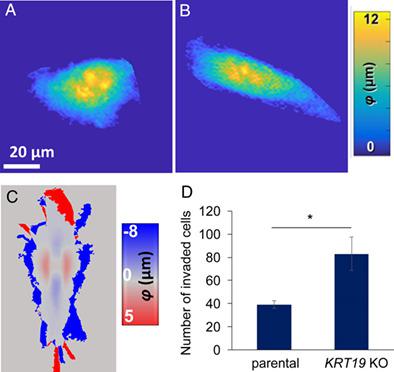当前位置:
X-MOL 学术
›
Cytom. Part A
›
论文详情
Our official English website, www.x-mol.net, welcomes your
feedback! (Note: you will need to create a separate account there.)
Morphology, Motility, and Cytoskeletal Architecture of Breast Cancer Cells Depend on Keratin 19 and Substrate.
Cytometry Part A ( IF 2.5 ) Pub Date : 2020-04-14 , DOI: 10.1002/cyto.a.24011 Van K Lam 1 , Pooja Sharma 2 , Thanh Nguyen 3 , Georges Nehmetallah 3 , Christopher B Raub 1 , Byung Min Chung 2
Cytometry Part A ( IF 2.5 ) Pub Date : 2020-04-14 , DOI: 10.1002/cyto.a.24011 Van K Lam 1 , Pooja Sharma 2 , Thanh Nguyen 3 , Georges Nehmetallah 3 , Christopher B Raub 1 , Byung Min Chung 2
Affiliation

|
Cancer cells gain motility through events that accompany modulation of cell shape and include altered expression of keratins. However, the role of keratins in change of cancer cell architecture is not well understood. Therefore, we ablated the expression of keratin 19 (K19) in breast cancer cells of the MDA‐MB‐231 cell line and found that cells lacking K19 become more elongated in culture, with morphological reversion toward the parental phenotype upon transduction of KRT19. Also, the number of actin stress fibers and focal adhesions were significantly reduced in KRT19 knockout (KO) cells. The altered morphology of KRT19 KO cells was then characterized quantitatively using digital holographic microscopy (DHM), which not only confirmed the phenotypic change of KRT19 KO cells but also identified that the K19‐dependent morphological change is dependent on the substrate type. A new quantitative method of single cell analysis from DHM, via average phase difference maps, facilitated evaluation of K19–substrate interactive effects on cell morphology. When plated on collagen substrate, KRT19 KO cells were less elongated and resembled parental cells. Assessing single cell motility further showed that while KRT19 KO cells moved faster than parental cells on a rigid surface, this increase in motility became abrogated when cells were plated on collagen. Overall, our study suggests that K19 inhibits cell motility by regulating cell shape in a substrate‐dependent manner. Thus, this study provides a potential basis for the altered expression of keratins associated with change in cell shape and motility of cancer cells. © 2020 International Society for Advancement of Cytometry
中文翻译:

乳腺癌细胞的形态学、运动性和细胞骨架结构取决于角蛋白 19 和底物。
癌细胞通过伴随细胞形状调节的事件获得运动性,包括改变角蛋白的表达。然而,角蛋白在改变癌细胞结构中的作用尚不清楚。因此,我们消除了 MDA-MB-231 细胞系乳腺癌细胞中角蛋白 19 (K19) 的表达,发现缺乏 K19 的细胞在培养中变得更加细长,在转导KRT19后形态学向亲本表型转变。此外,在KRT19敲除 (KO) 细胞中,肌动蛋白应力纤维和粘着斑的数量显着减少。KRT19的形态改变然后使用数字全息显微镜 (DHM) 对 KO 细胞进行定量表征,这不仅证实了KRT19 KO 细胞的表型变化,而且确定了 K19 依赖性形态变化取决于底物类型。一种新的 DHM 单细胞分析定量方法,通过平均相位差图,有助于评估 K19-底物对细胞形态的相互作用影响。当铺在胶原基质上时,KRT19 KO 细胞的伸长率较低,并且类似于亲代细胞。评估单细胞运动进一步表明,虽然KRT19KO 细胞在刚性表面上比亲代细胞移动得更快,当细胞被镀在胶原蛋白上时,这种运动性的增加就被消除了。总体而言,我们的研究表明,K19 通过以底物依赖性方式调节细胞形状来抑制细胞运动。因此,这项研究为与癌细胞的细胞形状和运动性变化相关的角蛋白表达改变提供了潜在的基础。© 2020 国际细胞术进步协会
更新日期:2020-04-14
中文翻译:

乳腺癌细胞的形态学、运动性和细胞骨架结构取决于角蛋白 19 和底物。
癌细胞通过伴随细胞形状调节的事件获得运动性,包括改变角蛋白的表达。然而,角蛋白在改变癌细胞结构中的作用尚不清楚。因此,我们消除了 MDA-MB-231 细胞系乳腺癌细胞中角蛋白 19 (K19) 的表达,发现缺乏 K19 的细胞在培养中变得更加细长,在转导KRT19后形态学向亲本表型转变。此外,在KRT19敲除 (KO) 细胞中,肌动蛋白应力纤维和粘着斑的数量显着减少。KRT19的形态改变然后使用数字全息显微镜 (DHM) 对 KO 细胞进行定量表征,这不仅证实了KRT19 KO 细胞的表型变化,而且确定了 K19 依赖性形态变化取决于底物类型。一种新的 DHM 单细胞分析定量方法,通过平均相位差图,有助于评估 K19-底物对细胞形态的相互作用影响。当铺在胶原基质上时,KRT19 KO 细胞的伸长率较低,并且类似于亲代细胞。评估单细胞运动进一步表明,虽然KRT19KO 细胞在刚性表面上比亲代细胞移动得更快,当细胞被镀在胶原蛋白上时,这种运动性的增加就被消除了。总体而言,我们的研究表明,K19 通过以底物依赖性方式调节细胞形状来抑制细胞运动。因此,这项研究为与癌细胞的细胞形状和运动性变化相关的角蛋白表达改变提供了潜在的基础。© 2020 国际细胞术进步协会











































 京公网安备 11010802027423号
京公网安备 11010802027423号